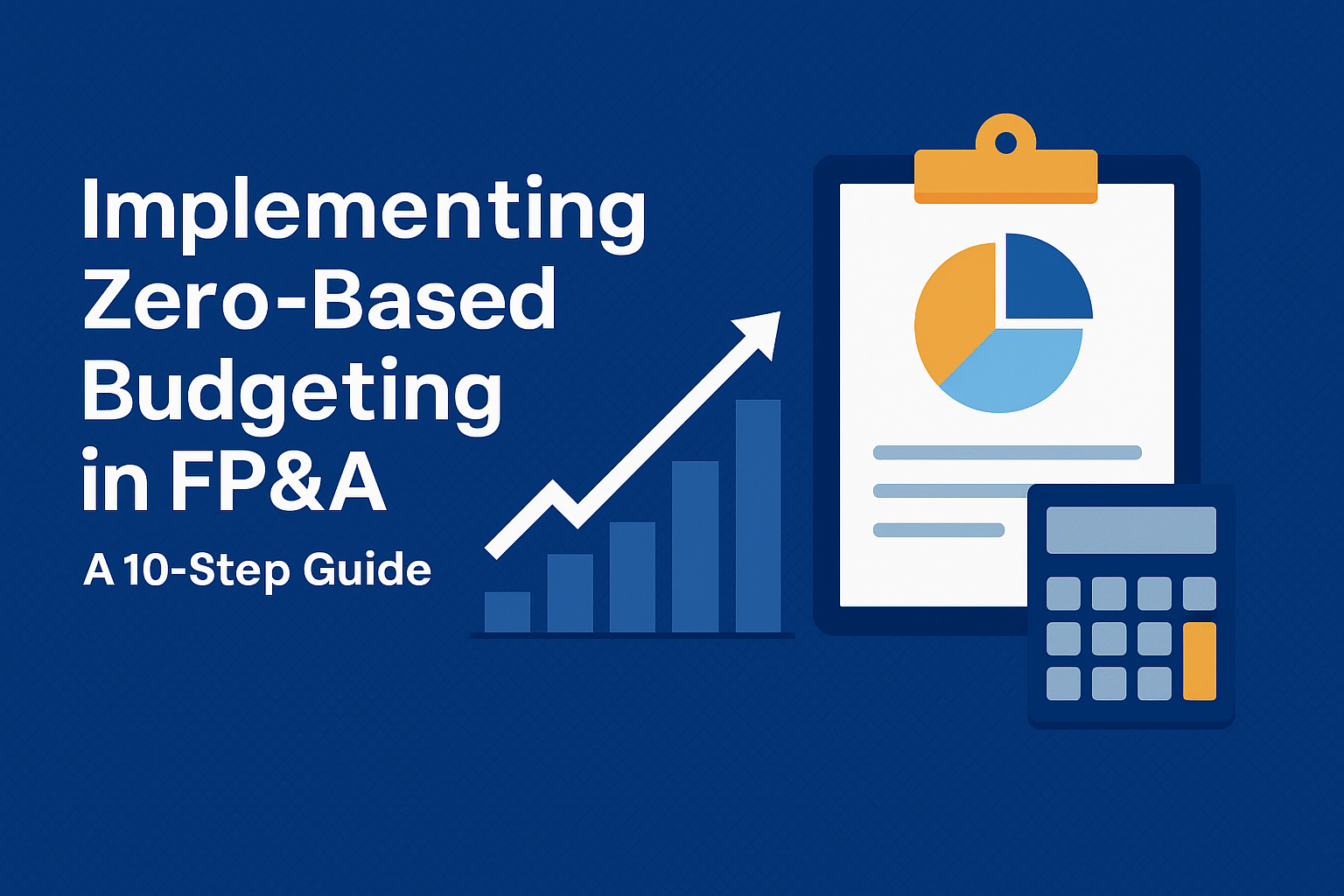Modernizing FP&A with 21st Century Zero-Based Budgeting
The traditional budgeting process is broken. We know it, we live with it, and every December or January, we perform the same ritual — copy last year’s numbers, slap on a 3% increase, and call it strategic planning. That’s not strategy. That’s spreadsheet theater. As someone who has spent years entrenched in M&A integration, post-acquisition finance redesign, and running FP&A for multiple divisions, I’ve seen firsthand what works and what wastes time. And the truth is: Zero-Based Budgeting (ZBB), when done right, works. But not the crusty version from the 1970s — I’m talking about 21st-century ZBB that’s integrated, dynamic, and operationally relevant.
Why We Need to Modernize Budgeting
In my years integrating financial functions post-acquisition — from Orlando to Atlanta and everywhere in between — one truth has remained: budget processes are often the last thing to get updated. HR systems get revamped, CRM gets shiny and new, but budgeting? It’s still that Excel file from 2007 passed around like a sacred text.
Here’s the reality: modern operators need:
- Agility: Static plans don’t cut it. Budgets must adapt.
- Accountability: Visibility down to the cost center is a must.
- Alignment: Finance, HR, Sales, Ops — all singing from the same P&L hymnal.
- Actionability: Budgets should inform decisions, not just memorialize them.
What is Modern Zero-Based Budgeting?
Classic ZBB required every line item to be justified from scratch. Painful. Tedious. Often more performative than transformative. But 21st-century ZBB isn’t about putting managers through death-by-PowerPoint justifying paperclip purchases. It’s about linking cost to value, spending to strategy.
In a modern framework, ZBB:
- Focuses on activities, not just accounts
- Uses technology to simplify justification workflows
- Embeds accountability into the organization
- Creates a culture of cost ownership and operational efficiency
- Leverages forecasting and scenario planning for strategic insight
My ZBB Journey: From Post-Acquisition Chaos to Financial Clarity
When I joined Stax, I walked into a post-acquisition labyrinth. Multiple subsidiaries, no standardized reporting, and a finance function that was more survival-mode than strategic partner. As interim controller, I didn’t just have to get the books closed — I had to turn the lights on.
What worked?
- Implementing Netsuite with multibook and multi-currency capabilities gave us real-time visibility.
- Standardizing reporting packages brought cohesion to internal, board, and bank-facing deliverables.
- But most critically — building a ZBB-informed financial roadmap across FP&A, Accounting, HR, and Commissions created alignment across functions.
ZBB allowed us to:
- Stop the rinse-repeat budgeting cycle
- Hold functional leads accountable for their cost structure
- Identify hidden inefficiencies and redeploy capital to growth-driving initiatives
- Align cost decisions with broader business priorities
Why Most ZBB Efforts Fail
Let’s be honest — ZBB gets a bad rap. And deservedly so. Too many CFOs jump in thinking ZBB is a plug-and-play fix. It’s not. It’s cultural. It requires leadership buy-in and operational partnership. Here are the usual culprits:
- Overengineering: If your ZBB tool requires a PhD in finance to operate, it’s going to die on the vine.
- Lack of executive buy-in: If your COO isn’t bought in, you’ll get sandbagging, not strategy.
- Data chaos: Garbage in, garbage out. ZBB without data hygiene is like cooking a five-star meal in a dorm room microwave.
- Poor communication: Rolling out a budget revolution without a narrative is a surefire way to build resistance.
Traditional Budgeting vs. Modern ZBB
| Criteria | Traditional Budgeting | Modern ZBB |
|---|---|---|
| Basis | Prior year actuals | Justified from zero |
| Frequency | Annual | Continuous or quarterly |
| Technology | Excel-heavy | Integrated FP&A platforms |
| Accountability | Top-down | Bottom-up and functionally owned |
| Flexibility | Low | High |
| Link to Strategy | Weak | Strong |
| Culture | Compliance-driven | Performance and value-driven |
How I Got Operators to Embrace ZBB (Without Revolts)
At Michelin Connected Fleet, I had to modernize not just Finance, but HR and Business Support too. Imagine walking into a sales org and telling them their budget will be reset to zero. You’ll be less popular than a PowerPoint on a Friday.
So I reframed it:
- I didn’t say “we’re cutting” — I said “we’re reallocating.”
- I didn’t talk about “ZBB” — I talked about building a cost culture.
- I partnered with Sales to redesign comp plans that drove the right behaviors.
- I aligned incentives and metrics with tangible outcomes, not just cost containment.
The lesson? Change management matters. Terminology matters. People don’t hate budgets — they hate irrelevant, top-down processes that ignore reality.
Tips for Implementing ZBB Without Torching Morale
- Start with OpEx: Don’t ZBB your entire P&L on Day 1. Start with controllable costs like T&E, marketing, or facilities.
- Use technology: Tools like Anaplan, Workday Adaptive, or Vena can turn ZBB from slog to strategic.
- Educate, don’t dictate: Train budget owners to understand what ZBB is — and more importantly, what it isn’t.
- Involve operators early: Finance doesn’t own the cost base — your department heads do.
- Track value creation: Tie cost cuts or reallocations to strategic goals — product launches, customer success, or hiring.
- Build trust: Transparency in goals and data creates alignment and buy-in.
- Use pilot programs: Test ZBB with a single department and scale based on learnings.
Bulletproofing Your ZBB Rollout: Lessons from the Trenches
Based on my experience across Fleetcor, NexTraq, Michelin, and private equity-backed firms, here’s my battle-tested checklist before rolling out ZBB:
- Conduct a baseline cost review
- Assess financial system readiness (cloud-based ERP is table stakes)
- Identify ZBB champions in each function
- Build executive dashboards that visualize cost-to-value ratios
- Run pilot programs before a full rollout
- Document and broadcast wins from early adopters
- Make adjustments based on frontline feedback
ZBB in the Age of AI and Automation
Let’s not ignore the elephant in the spreadsheet: artificial intelligence. Modern ZBB isn’t just about budgets — it’s about forecasting, scenario planning, and predictive insights. I’ve seen organizations move from static Excel workbooks to dynamic models that forecast churn, adjust headcount, and simulate cost changes in real time.
If your FP&A function isn’t leveraging:
- Driver-based modeling
- AI-powered variance analysis
- Predictive headcount planning
- Real-time dashboards that integrate operations and finance KPIs
Then your ZBB is still riding with training wheels.
Ask yourself: is your FP&A team building budgets, or building business intelligence?
Wrapping up: ZBB as a Strategic Weapon
I’m not here to sell you a silver bullet — there isn’t one. But what I am telling you — from one finance leader to another — is that ZBB, done right, is a competitive advantage. It forces clarity, drives alignment, and most importantly, makes your budget mean something.
I’ve used it to stabilize post-acquisition chaos, to align multi-functional teams, and to win credibility with operators who used to see finance as the Department of No. It helped me shift Finance from gatekeeper to growth enabler.
This isn’t just theory — this is what worked in the trenches of real-world integration, from startups to multinationals.
We’re no longer in a world where yesterday’s numbers are good enough. So why are we still budgeting like it’s 1999?
What would your budget look like if every dollar had to fight for its place — and could prove it was worth it?









Leave a Reply
Want to join the discussion?Feel free to contribute!